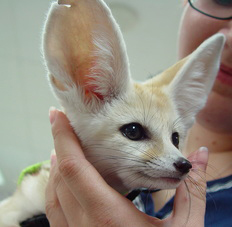Photos and edited by Susan Horton, DVM
Classification

Fennec foxes are in the canidae family, closely related to the red and artic fox. They live 12-16 years and reach sexual maturity at 9-11 mos. The female is known as a “vixen” and a male is known as a “reynard.” They originate from the sandy areas of the Sahara desert of North Africa , from Morocco & Niger to Egypt and Sudan . They are avid diggers, creating dens in which to live. Fennec foxes are considered threatened in the wild.
Anatomy/Physiology
They have soft, thick coats; coloration is reddish cream to fawn with a white underbelly. They are fastidious animals with no strong odor. They have a heavily furred tail with a gland at the end, whose function is as yet unknown. They have anal glands at the 5 and 7 o’clock position of the anus which is used as a scent gland and there are also glands between the toes. Fennec fox teeth are similar to that of dogs.
Behavior
The Fennec fox is a social animal, and may live in colonies of up to 10 animals. When approached, the captive fox will normally cower, lay on its side, yelp and wag its tail. They have also been known to purr. Fennec foxes can be taught to fetch, which allows for great exercise.
Housing

The Fennec fox should be kenneled when not supervised. A large dog crate or ferret cage would suffice. They should be kept in an area with low humidity and good ventilation. Avoid dusty or strong smelling bedding such as pine or cedar. They can be litter box trained and a covered cat box with a clay litter can be used.
Fennecs are strong diggers and good climbers so make sure to account for both when enclosed. These guys love to bask in the sun. If outside they should be on a harness and leash, but do not use a collar. Use caution even with a harness, because if startled they still may wiggle free.
Diet
Fennec foxes are omnivorous and eat a variety of foods in the wild. In captivity, they should be fed Mazuri Exotic Canine Diet (www.mazuri.com; 800-227-8941). You can then supplement with a variety of fresh fruits, vegetables, eggs, pinky mice, crickets and mealworms.
Be sure not to overfeed; an ideal weight is between 2 to 3lbs. Avoid items such as onions, garlic, chocolate, caffeine, avocado, etc as they are toxic.
Annual Checkup

All Fennecs should be spayed or neutered at around 6 months of age. They require annual vaccines. Please note that all medications and vaccines are considered “off-label” meaning they were not tested or approved for use in this species. Rabies vaccination is not recognized legally, but will protect you and your fox from the disease.
They should be vaccinated yearly for Rabies, Canine Distemper, Canine Parvo virus and Canine Hepatitis. They should be tested annually for heart worm disease and be on heartworm prevention as well as flea and tick preventative. They should have annual fecal exams.
Common Illnesses
Fennec Foxes are prone to many of the diseases we see in dogs. Many of these are husbandry related and can be prevented. Some common illness include: kidney disease, liver disease, heart disease, pneumonia, skin infections/mites, eye infections or glaucoma, intestinal parasites, dental disease and histoplasmosis.
Fennec foxes can also carry some disease that may be contagious to people such as: Tuberculosis, Rabies, Leishmaniasis, and some intestinal parasites.
Vital Statistics

|
Body Weight
|
20cm
|
|
Body Weight
|
1-1.5kg (2-3lb)
|
|
Normal Body Temperature
|
100.8 F
|
|
Respiration Rate
|
23 bpm
|
|
Average Lifespan
|
12-16 years
|
|
Maximum Lifespan
|
10 years
|
|
Age of Sexual Maturity
|
9-11 months
|
|
Gestation
|
49-63 days
|
|
Litter size
|
2-5 kits
|
|
Weaning
|
8-10 weeks
|
Reference
Exotic DVM Veterinary Magazine Vol 5.4

